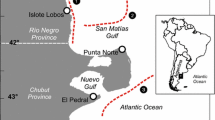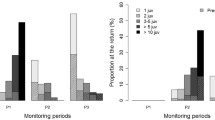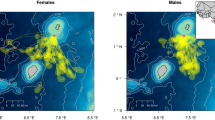Abstract
Recently emerged brook charr (Salvelinus fontinalis) foraging in still-water pools along the sides of streams are either active, feeding on insects from the upper portion of the water column away from the stream bank, or sedentary, feeding on crustaceans emerging from the hyporheic zone near the stream bank. We tested whether the frequency of movement displayed by individual brook charr searching for prey in the field was related to the relative volume of the telencephalon, a brain region involved with movement and space use in fishes. Movement of individuals searching for prey was quantified in the field, individuals were captured and volumes of the telencephalon and of the olfactory bulbs, a brain region neighbouring the telencephalon but not implicated in space use, were measured. Individuals with larger telencephalon volumes moved more frequently on average while searching for prey in the field than did individuals with smaller telencephalon volumes. The frequency of movement was unrelated to differences in the volume of the olfactory bulbs, suggesting that the relationship between telencephalon volume and movement was not a consequence of differences in overall brain size. Demonstrating a correlation between foraging behaviour and brain morphology for brook charr exhibiting different foraging tactics suggests that diversification in brain structure and function could be important aspects of the foraging specialization believed to occur during early stages in the evolution and development of resource polymorphisms.




Similar content being viewed by others
References
Baker JA, Cresko WA, Foster SA, Heins DC (2005) Life-history differentiation of benthic and limnetic ecotypes in a polytypic population of threespine stickleback (Gasterosteus aculeatus). Evol Ecol Res 7:121–131
Bass AH (1996) Shaping brain sexuality. Am Sci 84:352–363
Bertrand M, Marcogliese DJ, Magnan P (2008) Trophic polymorphism in brook charr revealed by diet, parasites and morphometrics. J Fish Biol 72:555–572
Biro PA, Stamps JA (2008) Are animal personality traits linked to life-history productivity? Trends Ecol Evol 23:361–368
Broglio C, Rodríguez F, Salas C (2003) Spatial cognition and its neural basis in teleost fishes. Fish Fish 4:247–255
Brown HS (2002) Hematoxylin and eosin (the routine stain). H&H informational primer. Sigma-Aldrich Corporation, pp 1–3
Burnham KP, Anderson DR (2002) Model selection and multimodel inference: a practical information-theoretic approach, 2nd edn. Springer-Verlag, New York
Burns JG, Saravanan A, Rodd FH (2009) Rearing environment affects the brain size of guppies: lab-reared guppies have smaller brains than wild-caught guppies. Ethology 115:122–133
Clayton NS, Krebs JR (1994) Hippocampal growth and attrition in birds affected by experience. Proc Natl Acad Sci USA 91:7410–7414
Coggeshall RE (1992) A consideration of neural counting methods. Trends Neurosci 15:9–13
Day T, McPhail JD (1996) The effect of behavioural and morphological plasticity on foraging efficiency in the threespine stickleback (Gasterosteus sp). Oecologia 108:380–388
DeBose JL, Nevitt GA (2008) The use of odors at different spatial scales: comparing birds with fish. J Chem Ecol 34:867–881
De Kerckhove D, McLaughlin RL, Noakes DLG (2006) Ecological mechanisms favouring behavioural diversification in the absence of morphological diversification: a theoretical examination using brook charr (Salvelinus fontinalis). J Anim Ecol 75:506–517
Egas M, Sabelis MW, Vala F, Lesna I (2004) Adaptive speciation in agricultural pests. In: Dieckman U, Doebeli M, Metz JAJ (eds) Adaptive speciation. Cambridge University Press, Cambridge, pp 249–262
Ehlinger TJ (1990) Habitat choice and phenotype-limited feeding efficiency in bluegill: individual differences and trophic polymorphism. Ecology 71:886–896
Farwell M, McLaughlin RL (2009) Alternative foraging tactics and risk taking in brook charr (Salvelinus fontinalis). Behav Ecol 20:913–921
Grant JWA, Noakes DLG (1987) Movers and stayers: foraging tactics of young-of-the-year brook charr, Salvelinus fontinalis. J Anim Ecol 56:1001–1013
Healy SD, Rowe C (2007) A critique of comparative studies of brain size. Proc R Soc B-Biol Sci 274:453–464
Healy SD, Clayton NS, Krebs JR (1994) Development of hippocampal specialisation in two species of tit (Parus spp.). Behav Brain Res 61:23–28
Healy SD, de Kort SR, Clayton NS (2005) The hippocampus, spatial memory and food hoarding: a puzzle revisited. Trends Ecol Evol 20:17–22
Huey RB, Hertz PE, Sinervo B (2003) Behavioral drive versus behavioral inertia in evolution: a null model approach. Am Nat 161:357–366
Imre I, McLaughlin RL, Noakes DLG (2002) Phenotypic plasticity in brook charr: changes in caudal fin induced by water flow. J Fish Biol 61:1171–1181
Jacobs LF, Gaulin SJC, Sherry DF, Hoffman GE (1990) Evolution of spatial cognition: sex-specific patterns of spatial behavior predict hippocampal size. Proc Natl Acad Sci USA 87:6349–6352
Koolhaas JM, Korte SM, De Boer SF, Van Der Vegt BJ, Van Reenen CG, Hopster H, De Jong IC, Ruis MAW, Blokhuis HJ (1999) Coping styles in animals: current status in behavior and stress-physiology. Neurosci Biobehav Rev 23:925–935
Kotrschal K, Van Staaden MJ, Huber R (1998) Fish brains: evolution and environmental relationships. Rev Fish Biol Fish 8:373–408
Krebs JR (1990) Food-storing birds: adaptive specialization in brain and behaviour? Phil Trans R Soc Lon Ser B-Biol 329:153–160
Krebs JR, Sherry DF, Healy SD, Perry VH, Vaccarino AL (1989) Hippocampal specialization of food-storing birds. Proc Natl Acad Sci USA 86:1388–1392
Krebs JR, Clayton NS, Healy SD, Cristol DA, Patel SN, Jolliffe AR (1996) The ecology of the avian brain: food-storing memory and the hippocampus. Ibis 138:34–46
Kruska D (1988) Mammalian domestication and its effect on brain structure and behavior. In: Jerison HJ, Jerison I (eds) Intelligence and evolutionary biology. Springer, Berlin, pp 211–250
LaDage LD, Riggs BJ, Sinervo B, Pravosudov VV (2009) Dorsal cortex volume in male side-blotched lizards, Uta stansburiana, is associated with different space use strategies. Anim Behav 78:91–96
Lefebvre L, Whittle P, Lascaris E, Finkelstein A (1997) Feeding innovations and forebrain size in birds. Anim Behav 53:549–560
López JC, Broglio C, Rodríguez F, Thinus-Blanc C, Salas C (2000) Reversal learning deficit in a spatial task but not in a cued one after telencephalic ablation in goldfish. Behav Brain Res 109:91–98
Malmquist HJ, Snorrason SS, Skúlason S, Jonsson B, Sandlund OT, Jonasson PM (1992) Diet differentiation in polymorphic arctic charr in Thingvallavatn, Iceland. J Anim Ecol 61:21–35
Marchetti MP, Nevitt GA (2003) Effects of hatchery rearing on brain structures of rainbow trout, Oncorhynchus mykiss. Environ Biol Fish 66:9–14
McLaughlin RL, Grant JWA (1994) Morphological and behavioural differences among recently-emerged brook charr, Salvelinus fontinalis, foraging in slow- vs. fast-running water. Environ Biol Fish 39:289–300
McLaughlin RL, Grant JWA, Kramer DL (1992) Individual variation and alternative patterns of foraging movements in recently-emerged brook charr (Salvelinus fontinalis). Behaviour 120:286–301
McLaughlin RL, Grant JWA, Kramer DL (1994) Foraging movements in relation to morphology, water-column use, and diet for recently emrged brook trout (Salvelinus fontinalis) in still-water pools. Can J Fish Aquat Sci 51:268–279
McLaughlin RL, Ferguson MM, Noakes DLG (1995) Tissue concentrations of RNA and protein for juvenile brook trout (Salvelinus fontinalis): lagged responses to fluctuations in food availability. Fish Physiol Biochem 14:459–469
McLaughlin RL, Ferguson MM, Noakes DLG (1999) Adaptive peaks and alternative foraging tactics in brook charr: evidence of short-term divergent selection for sitting-and-waiting and actively searching. Behav Ecol Sociobiol 45:386–395
Moran MD (2003) Arguments for rejecting the sequential Bonferroni in ecological studies. Oikos 100:403–405
Ohnishi K (1997) Effects of telencephalic ablation on short-term memory and attention in goldfish. Behav Brain Res 86:191–199
Olsson J, Quevedo M, Colson C, Svanback R (2007) Gut length plasticity in perch: into the bowels of resource polymorphisms. Biol J Linn Soc 90:517–523
Øverli Ø (2007) Preface: plasticity and diversity in behavior and brain function—important raw material for natural selection? Brain Behav Evol 70:215–217
Øverli Ø, Winberg S, Pottinger TG (2005) Behavioral and neuroendocrine correlates of selection for stress responsiveness in rainbow trout—a review. Integr Comp Biol 45:463–474
Parsons KJ, Robinson BW (2007) Foraging performance of diet-induced morphotypes in pumpkinseed sunfish (Lepomis gibbosus) favours resource polymorphism. J Evol Biol 20:673–684
Perrot-Sinal TS, Kavaliers M, Ossenkopp KP (1998) Spatial learning and hippocampal volume in male deer mice: relations to age, testosterone and adrenal gland weight. Neuroscience 86:1089–1099
Pollen AA, Dobberfuhl AP, Scace J, Igulu MM, Renn SCP, Shumway CA, Hofmann HA (2007) Environmental complexity and social organization sculpt the brain in Lake Tanganyikan cichlid fish. Brain Behav Evol 70:21–39
Réale D, Reader SM, Sol D, McDougall PT, Dingemanse NJ (2007) Integrating animal temperament within ecology and evolution. Biol Rev 82:291–318
Reist JD (1985) An empirical evaluation of several univariate methods that adjust for size variation in morphometric data. Can J Zool 63:1429–1439
Robinson BW, Wilson DS (1994) Character release and displacement in fishes: a neglected literature. Am Nat 144:596–627
Robinson BW, Wilson DS (1996) Genetic variation and phenotypic plasticity in a trophically polymorphic population of pumpkinseed sunfish (Lepomis gibbosus). Evol Ecol 10:631–652
Rodríguez F, López JC, Vargas JP, Gómez Y, Broglio C, Salas C (2002) Conservation of spatial memory function in the pallial forebrain of reptiles and ray-finned fishes. J Neurosci 22:2894–2903
Rowland JM, Emlen DJ (2009) Two thresholds, three male forms result in facultative male trimorphism in beetles. Science 323:773–776
Rowland JM, Qualls CR (2005) Likelihood models for discriminating alternative phenotypes in morphologically dimorphic species. Evol Ecol Res 7:421–434
Salas C, Broglio C, Rodríguez F, López JC, Portavella M, Torres B (1996) Telencephalic ablation in goldfish impairs performance in a 'spatial constancy' problem but not in a cued one. Behav Brain Res 79:193–200
Schjolden J, Pulman KGT, Metcalfe NB, Winberg S (2006) Divergence in locomotor activity between two strains of rainbow trout Oncorhynchus mykiss with contrasting stress responsiveness. J Fish Biol 68:920–924
Schluter D, McPhail JD (1992) Ecological character displacement and speciation in sticklebacks. Am Nat 140:85–108
Schluter D, McPhail JD (1993) Character displacement and replicate adaptive radiation. Trends Ecol Evol 8:197–200
Scott WB, Crossman EJ (1998) Freshwater fishes of Canada. Galt house publications Ltd., Oakville
Sherry DF, Hoshooley JS (2009) The seasonal hippocampus of food-storing birds. Behav Proc 80:334–338
Shumway CA (2008) Habitat complexity, brain, and behavior. Brain Behav Evol 72:123–134
Skúlason S, Smith TB (1995) Resource polymorphisms in vertebrates. Trends Ecol Evol 10:366–370
Smith RJ (1980) Rethinking allometry. J Theor Biol 87:97–111
Smith TB, Skúlason S (1996) Evolutionary significance of resource polymorphisms in fishes, amphibians, and birds. Annu Rev Ecol Syst 27:111–133
Snorrason SS, Skúlason S (2004) Adaptive speciation in northern freshwater fishes. In: Dieckman U, Doebeli M, Metz JAJ (eds) Adaptive speciation. Cambridge University Press, Cambridge, pp 210–222
Stamps JA (2007) Growth-mortality tradeoffs and 'personality traits' in animals. Ecol Lett 10:355–363
Stephens DW, Krebs JR (1987) Foraging theory. Princeton University Press, Princeton
Svanback R, Bolnick DI (2007) Intraspecific competition drives increased resource use diversity within a natural population. Proc R Soc B-Biol Sci 274:839–844
Westfall PH, Young SS (1993) Resampling-based multiple testing: examples and methods for P-value adjustment. Wiley, New York
Wilson ADM, Godin J-GJ (2009) Boldness and behavioral syndromes in the bluegill sunfish, Lepomis macrochirus. Behav Ecol 20:231–237
Wilson ADM, Godin J-GJ (2010) Boldness and intermittent locomotion in the bluegill sunfish, Lepomis macrochirus. Behav Ecol 21:57–62
Wilson ADM, McLaughlin RL (2007) Behavioural syndromes in brook charr, Salvelinus fontinalis: prey-search in the field corresponds with space use in novel laboratory situations. Anim Behav 74:689–698
Zupanc GKH (2006) Neurogenesis and neuronal regeneration in the adult fish brain. J Comput Phys 192:649–670
Acknowledgements
We thank two anonymous referees and Drs. N. Bernier, E. Boulding, D. Noakes and J. Fryxell for comments on earlier drafts of the manuscript, S. Burosch for assistance in the field, T. Zufelt for assistance with illustrations, E. Niimi for assistance with the brain histology, R. Frank and M. Cornish for technical support in Hagen Aqualab, and the Ontario Ministry of Natural Resources for permission to collect fish for scientific purposes. This research was supported by a Natural Sciences and Engineering Council Canada Discovery grant to RLM and was approved by the University of Guelph Animal Care Committee (Animal Care Utilization Protocol no. 04R049). The authors declare that they have no conflict of interest.
Author information
Authors and Affiliations
Corresponding author
Additional information
Communicated by J. Krause
Rights and permissions
About this article
Cite this article
Wilson, A.D.M., McLaughlin, R.L. Foraging behaviour and brain morphology in recently emerged brook charr, Salvelinus fontinalis . Behav Ecol Sociobiol 64, 1905–1914 (2010). https://doi.org/10.1007/s00265-010-1002-4
Received:
Revised:
Accepted:
Published:
Issue Date:
DOI: https://doi.org/10.1007/s00265-010-1002-4




